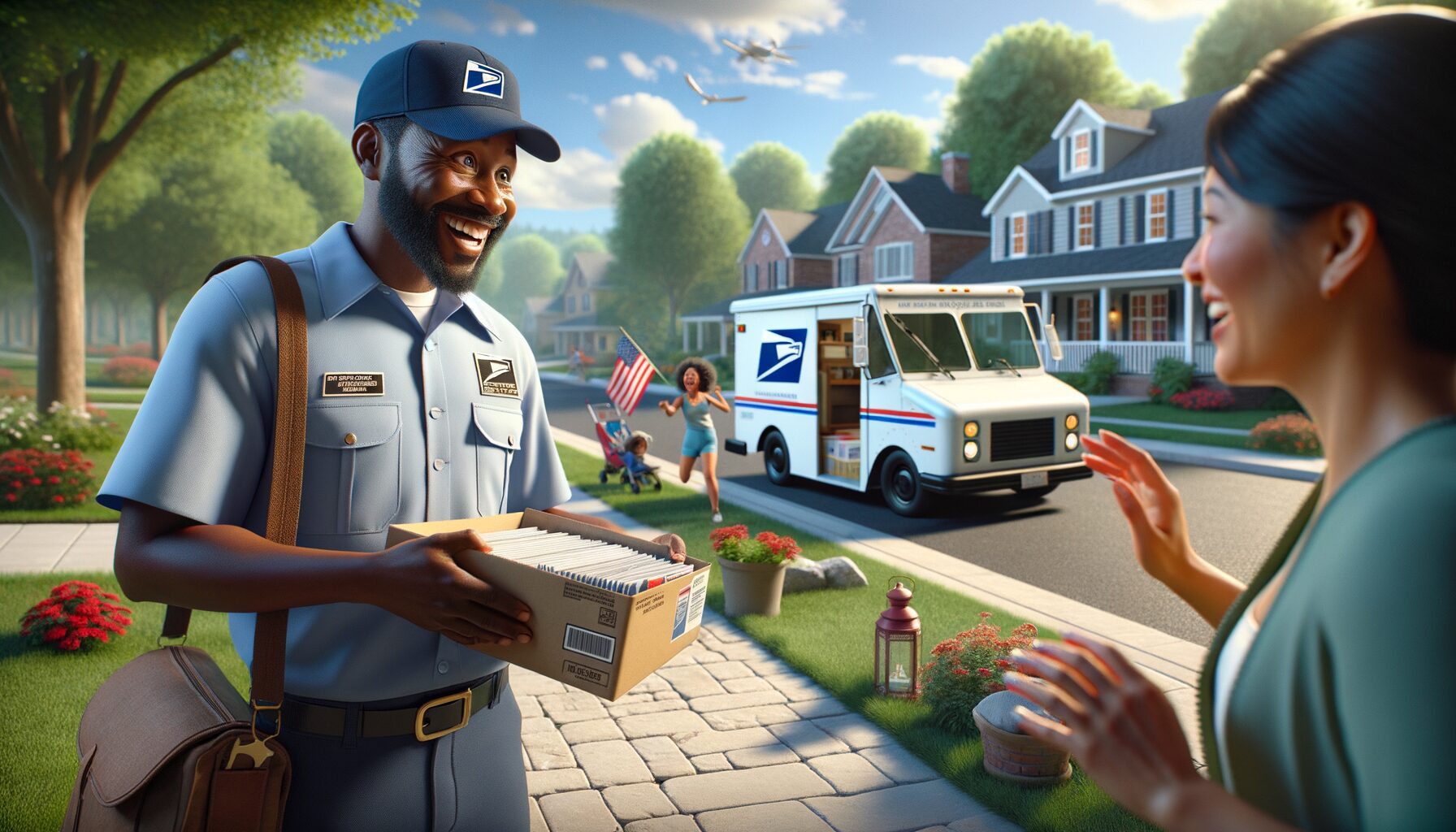
The United States Postal Service (USPS) is a crucial component of national communication and commerce. It currently operates on a six-day delivery schedule, from Monday to Saturday. This schedule has been a longstanding practice, ensuring consistent service across urban and rural areas. The question arises: Should USPS offer Sunday delivery to enhance its service offerings and meet modern demands
Evolution of Delivery Days
USPS has a rich history dating back to the late 18th century. Initially, mail delivery was infrequent and limited in scope. As the nation expanded, the demand for regular postal services increased. By the mid-20th century, a six-day delivery schedule became the norm. This schedule was designed to balance operational efficiency with customer needs. Sunday delivery was not considered necessary at that time, given the slower pace of communication and commerce.
Competitors Offering Weekend Delivery

The delivery landscape has changed significantly in recent years. Competitors like FedEx and UPS have introduced more flexible delivery options. These include weekend and even Sunday deliveries in many areas. This shift has been driven by the rise of e-commerce and consumer expectations for faster service. In contrast, USPS has maintained its traditional six-day schedule. This raises the question: Should USPS offer Sunday delivery to remain competitive in the market?
USPS faces unique challenges in maintaining its extensive network. It must balance service quality with financial sustainability. Operating six days a week allows USPS to manage costs effectively. Adding a seventh day could increase operational expenses significantly. These include additional labor costs, fuel, and vehicle maintenance. USPS must carefully consider these factors before expanding its delivery schedule.
USPS serves a diverse range of communities, from bustling cities to remote rural areas. The current delivery model ensures that all Americans have access to postal services. However, the demand for Sunday delivery may vary between regions. Urban areas with high e-commerce activity might benefit more from Sunday delivery. In contrast, rural areas may not see the same level of demand. USPS must assess regional needs when considering service expansions.
Technological Advancements
Technological advancements have transformed the postal industry. Automation and digital tools have improved efficiency and tracking capabilities. These innovations could support the implementation of Sunday delivery. However, USPS must invest in technology to ensure seamless operations. This includes upgrading sorting facilities and enhancing delivery route planning. Such investments could make Sunday delivery more feasible in the long term.
Consumer Expectations
Consumer expectations have shifted significantly in recent years. The rise of online shopping has increased demand for faster delivery options. Many consumers now expect weekend deliveries as a standard service. USPS must consider these market trends when evaluating its delivery model. Offering Sunday delivery could align USPS with consumer expectations and enhance its competitive position.
The question of whether USPS should offer Sunday delivery is complex. It involves balancing operational efficiency, cost considerations, and consumer demand. As the postal industry continues to evolve, USPS must adapt to remain relevant and competitive.
Potential Benefits of Sunday Delivery

Sunday delivery could significantly enhance customer satisfaction by offering greater convenience. Many consumers value the ability to receive packages on weekends. This service would cater to individuals with busy weekday schedules. It would also benefit those who require urgent deliveries over the weekend. By providing Sunday delivery, USPS could improve its reputation for customer service. Meeting these needs could lead to increased customer loyalty and positive feedback.
Positive Impact on E-commerce and Retail Sectors
The e-commerce sector has experienced substantial growth in recent years. Online retailers often promise quick delivery to attract customers. Sunday delivery could support these promises, making USPS a preferred partner for e-commerce businesses. Retailers could benefit from faster inventory turnover and increased sales. This service could also help small businesses compete with larger companies. By facilitating quicker deliveries, USPS could play a crucial role in the retail supply chain.
Competitive Advantage in the Delivery Market
The delivery market is highly competitive, with several major players. Companies like FedEx and UPS already offer Sunday delivery in many areas. By introducing this service, USPS could level the playing field. It would demonstrate USPS’s commitment to meeting modern consumer demands. This move could attract new customers who prioritize weekend delivery options. It could also retain existing customers who might otherwise switch to competitors.
Opportunities for Strategic Partnerships
Sunday delivery could open doors for strategic partnerships with retailers and e-commerce platforms. Collaborations could involve exclusive delivery agreements or promotional campaigns. These partnerships could enhance USPS’s visibility and market reach. Retailers might offer special deals for Sunday deliveries, boosting sales. Such collaborations could also lead to innovative delivery solutions tailored to specific market needs.
Offering Sunday delivery could positively impact USPS’s brand image. It would signal adaptability and responsiveness to consumer needs. This service could enhance public perception of USPS as a modern and customer-focused organization. Improved brand image could lead to increased customer loyalty and trust. It could also attract positive media attention and public support.
Potential for Increased Revenue

Sunday delivery could generate additional revenue for USPS. By charging a premium for this service, USPS could offset operational costs. Increased package volumes on Sundays could also contribute to higher overall revenue. This service could attract new business from retailers seeking faster delivery options. By capitalizing on these opportunities, USPS could strengthen its financial position.
The potential benefits of Sunday delivery are multifaceted. They encompass customer satisfaction, competitive advantage, and revenue growth. USPS must weigh these benefits against operational challenges and costs. By doing so, it can make informed decisions about service expansion.
Challenges and Considerations
Implementing Sunday delivery involves significant operational challenges. USPS would need to adjust its logistics framework to accommodate an additional delivery day. This includes revising delivery routes, schedules, and resource allocation. The current infrastructure is optimized for a six-day delivery model. Transitioning to a seven-day schedule requires careful planning and execution. Additional vehicles and staff would be necessary to meet increased demand. These changes could strain existing resources and require substantial investment.
The financial implications of Sunday delivery are a critical consideration. USPS operates under tight budget constraints, making cost management essential. Expanding delivery services could lead to increased operational expenses. These include labor, fuel, and maintenance costs associated with an extra delivery day. A detailed cost analysis is essential to determine the feasibility of Sunday delivery. USPS must assess whether potential revenue offsets these additional costs. Should USPS offer Sunday delivery, it must ensure financial sustainability.
Sunday delivery would significantly impact USPS employees. It would require changes to existing labor agreements and work schedules. Employees might face increased workloads and altered shift patterns. Negotiations with labor unions would be necessary to implement these changes. USPS must consider employee well-being and job satisfaction in this process. Ensuring fair compensation and working conditions is crucial for maintaining workforce morale.
Expanding to Sunday delivery necessitates infrastructure upgrades. Sorting facilities and distribution centers must handle increased volumes efficiently. Technological advancements could support these operational changes. Automation and advanced tracking systems could enhance efficiency and accuracy. USPS must invest in technology to facilitate seamless Sunday operations. These investments are essential for maintaining service quality and reliability.
Consumer Demand and Expectations
Understanding consumer demand is essential for evaluating service expansions. Many consumers now expect faster and more flexible delivery options. The rise of e-commerce has heightened these expectations significantly. Weekend deliveries, including Sundays, are increasingly seen as standard. Consumers value the convenience of receiving packages on weekends. Meeting these expectations could enhance customer loyalty and satisfaction.
Feedback from Businesses and Retailers
Businesses and retailers have a vested interest in delivery services. Efficient delivery is crucial for maintaining customer satisfaction and competitive advantage. Retailers often rely on quick delivery to fulfill customer orders. Sunday delivery could provide a significant advantage in the retail sector. It would enable businesses to offer faster service and meet customer demands. Retailers might view this service as a valuable addition to their logistics strategies.
Community Feedback and Public Opinion
Public opinion is a critical factor in service expansion decisions. Community impact must be considered when evaluating new services. Sunday delivery could affect local communities in various ways. Increased traffic and noise might be concerns for some residents. Engaging with communities to address these concerns is essential. Public support and acceptance are vital for successful implementation.
Perspectives from USPS Employees and Labor Unions
USPS employees and labor unions are key stakeholders in service changes. Employee perspectives on workload and work-life balance are important. Labor unions play a significant role in negotiating work conditions. Engaging with employees and unions ensures fair and equitable implementation. Addressing employee concerns is crucial for maintaining workforce morale.
Case Studies of Similar Initiatives
Examining case studies of similar initiatives provides valuable insights. Other delivery companies have successfully implemented Sunday delivery. These examples highlight both benefits and challenges encountered. Lessons learned from these initiatives can inform USPS’s approach. Understanding the impact on operations and customer satisfaction is crucial. These case studies offer practical guidance for potential implementation.
Partnerships with e-commerce platforms could enhance Sunday delivery services. Collaborations could involve shared logistics and promotional efforts. E-commerce platforms might offer incentives for Sunday deliveries. These partnerships could increase USPS’s market reach and visibility. Joint initiatives could streamline operations and reduce costs. Such collaborations could benefit both USPS and its partners.
Engaging with stakeholders is essential for evaluating Sunday delivery. Understanding consumer demand, business needs, and community impact is crucial. Insights from employees, experts, and case studies inform strategic decisions. By considering these perspectives, USPS can align its services with market needs.
Strategic Pathways for Implementation
Technological advancements are crucial for expanding delivery services. Automation and digital tools can enhance operational efficiency. USPS must invest in technology to support Sunday delivery. Upgrading sorting facilities and optimizing delivery routes are essential. These improvements can reduce costs and improve service quality. Infrastructure enhancements are necessary to handle increased package volumes.
Pilot programs are valuable for testing new service initiatives. They provide insights into operational challenges and customer response. USPS can use pilot programs to evaluate the feasibility of Sunday delivery. These programs help identify potential issues and areas for improvement. Data from pilots inform broader implementation strategies. Strategic planning ensures a smooth transition to expanded services.
Long-term sustainability is a critical consideration for USPS. Service expansions must align with financial and operational goals. Sunday delivery could contribute to USPS’s growth and competitiveness. It offers opportunities for increased revenue and market share. However, careful analysis of costs and benefits is essential. USPS must ensure that service expansion supports long-term sustainability.
Consumer preferences are continually evolving. USPS must adapt to meet these changing demands. Offering flexible delivery options is increasingly important. Sunday delivery aligns with consumer expectations for convenience and speed. Meeting these preferences enhances customer loyalty and satisfaction. USPS must remain responsive to market trends and consumer needs.
Exploring Alternative Delivery Models
Alternative delivery models could complement Sunday delivery. USPS could explore partnerships with local businesses for last-mile delivery. These models could enhance service flexibility and efficiency. Exploring alternatives provides additional options for meeting consumer needs. USPS must consider diverse strategies to optimize service delivery.
Should USPS offer Sunday delivery, it must consider future implications. Technological advancements, strategic planning, and stakeholder engagement are crucial. USPS must balance challenges and opportunities for successful service expansion. By addressing these factors, USPS can enhance its services and market position.
